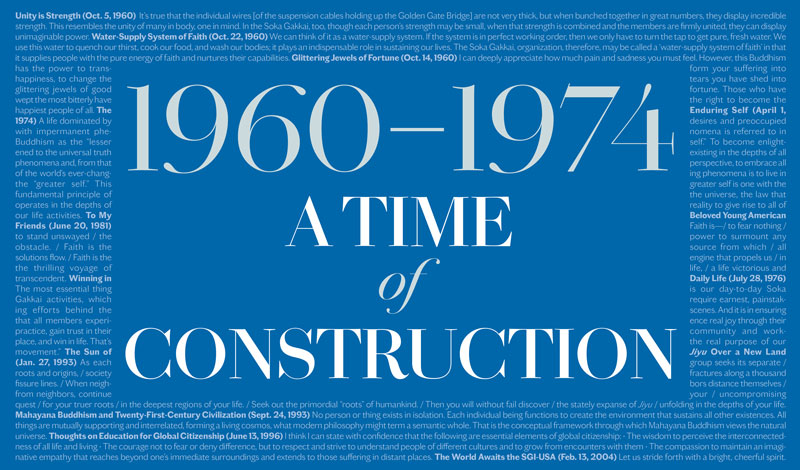To see the actual timeline please click here.
Ikeda Sensei made his first visit to the United States in October 1960, opening the way for worldwide kosen-rufu. By his second visit in January 1963, a a burgeoning Civil Rights Movement was exposing injustice, and a nuclear arms race was generating fear of attack from abroad.
Sensei visited the Los Angeles community center just ahead of its opening, marking the occasion with the calligraphy “Construction.” Its message would come to define the first period of kosen-rufu in the U.S., as the pioneering members traveled long distances to introduce even a single person to Buddhism and as young people from the nation’s peace movements began joining in droves.
With the founding of the World Tribune on Aug. 15, 1964, the SGI-USA acquired a megaphone for its nascent movement. The World Tribune introduced Buddhist principles that were largely unknown in Western society, including the “Ten Worlds,” “the oneness of life and its environment” and “human revolution.”
By the mid-1970s, the Watergate scandal and Vietnam War dominated the news, deepening prevailing distrust.
It was during this era that Sensei presented his first overseas university lecture, “The Enduring Self,” on April 1, 1974, at the University of California, Los Angeles (UCLA).
Just before departing for UCLA, Sensei shared with a small group of young men that the ideas he would be conveying during the lecture might be difficult to grasp at first. “This life philosophy is the forerunner of the 21st century, and its essence has not yet been touched upon by any scientist or philosopher,” he said.
“I am now just beginning to touch on this core of Buddhism, and it is only the start … just like the sunrise.”[1]
In his 75-minute speech, Sensei conveyed to the 600 college students present the Buddhist view that all phenomena are impermanent and that human beings suffer because they grow attached to and become shackled by their fleeting desires. He called for a shift from a civilization dominated by concerns of the “lesser self” to one based on the “greater self.”
“The 21st century must be a century of life, a century in which life is valued to the utmost,” he said. “Realizing the dream of a civilization that celebrates humanity depends on whether we can uncover the true nature of life, which is eternal, unchanging and invincible.”[2]
July 16, 1960
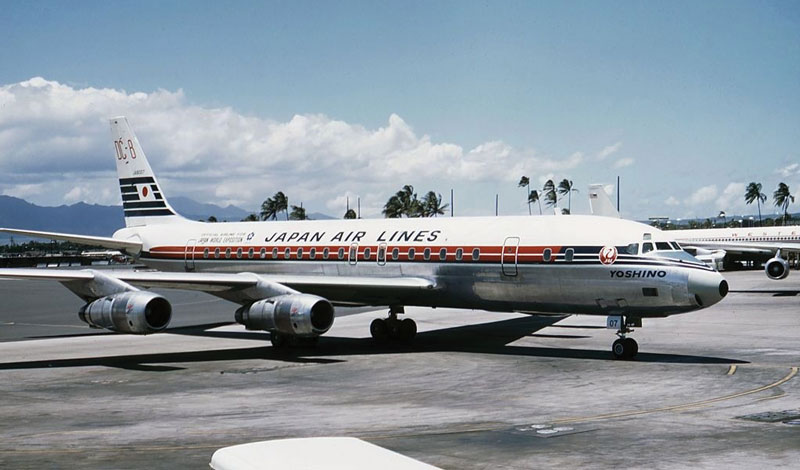
Did you know that the Douglas DC-8 aircraft that carried Ikeda Sensei and his delegation to the U.S. on his first overseas journey was manufactured in Long Beach, Calif.? The aircraft model, produced by Douglas Aircraft Company, opened the door to the jet age and was pivotal in establishing a new era of long-distance travel. Japan Airlines received its first DC-8 on July 16, 1960, 700 years to the day when Nichiren Daishonin submitted his treatise “On Establishing the Correct Teaching for the Peace of the Land.”
Oct. 2, 1960
The First Steps of Worldwide Kosen-rufu
Just five months after his inauguration as Soka Gakkai president on May 3, Ikeda Sensei and a small delegation traveled to the United States, Canada and Brazil to spread the humanistic philosophy of Nichiren Buddhism beyond the borders of Japan. In the U.S., they visited seven cities, meeting with the first Soka Gakkai members here, many of whom were Japanese women married to American servicemen and struggling with isolation in a foreign land.
In each city, district discussion meetings were held. Although these gatherings were small by Soka Gakkai standards, Sensei established the first districts and also Los Angeles Chapter. Thus, he created the framework for members to carry out their Buddhist practice, centered on the discussion meeting, while they sought to spread Buddhism in a vast new land.
1960
Discussion Meetings: The Heart of Our Movement
When Ikeda Sensei established the first districts in the United States in October 1960, he gave the following encouragement to the newly appointed leaders of Nevada District: “The district lies on the forefront of our movement and has a direct connection with each individual. At the same time, it is endowed with all of the functions necessary to support our daily activities. You might say that all our struggles in the realm of faith have centered on the district and that it is within the district that each of us has grown.
“If we liken the Soka Gakkai to an orchard, each district corresponds to a single fruit tree, while the fruit represents each of you. Without the tree, there will be no fruit. Every-thing depends on the tree. Similarly, the real basis of the Soka Gakkai is each district that composes it. One could even say that the district itself is the Soka Gakkai.
“When a district is formed and becomes fully functional, kosen-rufu in that area will progress by leaps and bounds” (The New Human Revolution, vol. 1, revised edition, pp. 113–14).
October 1960
Foundational Guidance
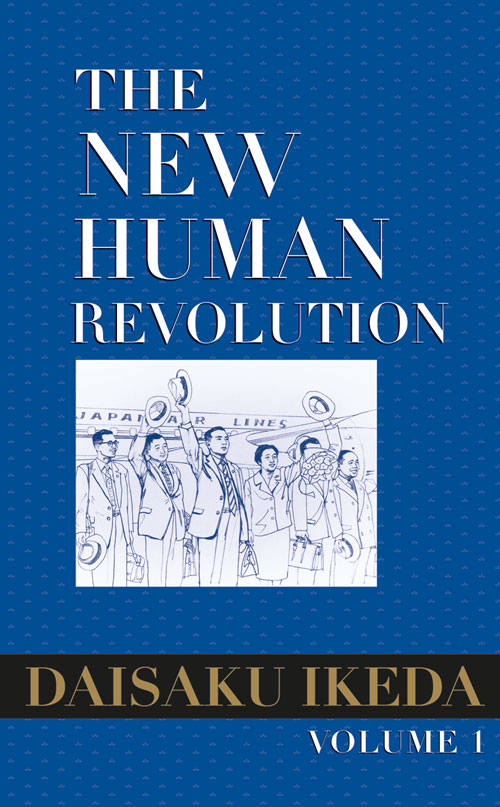
During his inaugural trip to the United States, Ikeda Sensei provided guidance and encouragement for the members regarding daily life, kosen-rufu activities and faith.
In one instance, he shared three guidelines for the pioneering members in San Francisco: 1) acquire citizenship and become good American citizens; 2) obtain a driver’s license; and 3) master English (see The New Human Revolution, vol. 1, revised edition, pp. 110–11).
A detailed log of this historic October 1960 trip and his foundational guidance can be found in volume 1 of The New Human Revolution.
Jan. 19, 1963
First Soka Gakkai Community Center Opens
To keep pace with the growing membership in the United States, Ikeda Sensei made leadership appointments and established new chapters on his second visit. He also established the first Soka Gakkai Buddhist center in the U.S.—the Los Angeles Community Center—which opened on Jan. 19, 1963, in East Los Angeles.
Aug. 15, 1964
The World Tribune Begins
On Aug. 15, 1964, the World Tribune printed its first edition—a four-page tabloid-sized newspaper with the first three pages in English and the fourth in Japanese.
With headlines such as “Respect for Job Should Be Same as That Shown Toward Gohonzon” and “Prayer, Faith, Unity and Study—Keys to Our Own Happiness,” it communicated to the English-speaking world the profundity of Nichiren Buddhism and the significance of the Soka Gakkai’s grassroots movement at a time when Buddhism had yet to transcend the framework of an ethnic Asian religion.
Ikeda Sensei had given the newspaper its name—and by extension, its mission—in May 1964, while flying from Mumbai to New Delhi in India. He chose World for its resolve to send the light of peace and hope to all humanity and Tribune for its role to protect ordinary people.
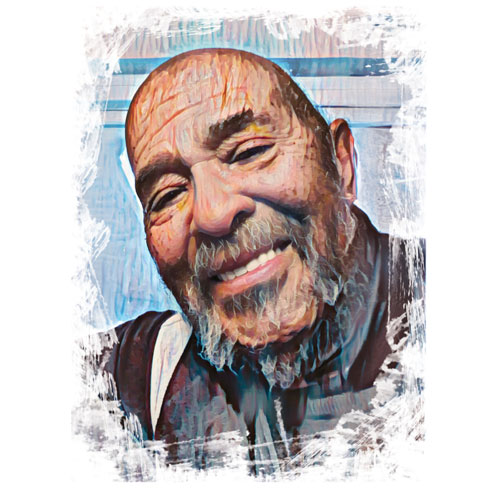
Kosen-rufu Is My Neighborhood
by Jimmy (James) Laws
Colorado Springs, Colo.
I encountered Buddhism in 1965, shortly before I got my first draft notice to Vietnam. My sponsor helped my wife make a sheepskin pouch so I could carry the Gohonzon with me. All I knew when I left was that, if I chanted Nam-myoho-renge-kyo and protected the Gohonzon, I would be protected.
Somehow all of my convoy commanders knew I had the Gohonzon, and it became our protection. When we were under fire, I would chant beneath my breath. When we made it out, here’d come the lieutenant saying, “Thank you, thank you.” It was like this for two years, back-to-back. I made it home.
Today, the fortune that I have from my Buddhist practice is like going from an anthill to Mount Sumeru! The practice taught me that it all comes down to me.
When I’m getting that anger, when everything negative is coming out of me, I come on upstairs, open the altar, look at the Gohonzon and sit right down. I take a deep breath, chant and reorganize myself.
When I read Ikeda Sensei’s messages in the publications, I always look for some food, some nourishment, something I can use for the day to be a better person.
Sensei taught me that if we can communicate, we can live in harmony with everything. I have a flock of little old birds that wait for me. I open the door, whistle and give them water and food. They are a part of my environment. I don’t go and set fire to a bush and burn it down. I help make this a livable corner.
When I see somebody coming, I make it a point to be outside where I can make contact—say good morning, how you doing? A lot of times, it seems—boom!—to open up their life.
We think of kosen-rufu on such a large scale but it’s really about our neighborhood, right?
July 1966
First English Translation of Nichiren Daishonin’s Writings Published
The English-language study journal Seikyo Times, the precursor to Living Buddhism, began translating Nichiren Daishonin’s writings into English, starting with the letter “Reply to Kyo’o.” This marked the first step in the ongoing translation and dissemination of Nichiren Daishonin’s writings to the English-speaking world.
1970s
Broadening Efforts for Peace
By the 1,000th issue of the World Tribune, Ikeda Sensei’s efforts for peace had expanded to the global stage. Arnold J. Toynbee, one of the leading historians of the 20th century, invited Sensei to exchange views on the fundamental issues confronting the world. Their first conversation took place in May 1972 in England, and their 40-hour dialogue, held across two years, was compiled in a book. This encounter sparked a series of Sensei’s dialogues with world leaders.
Starting in 1974, amid the heightening tensions of the Cold War, Sensei traveled to China, the Soviet Union and the United States as a citizen diplomat to build bridges of friendship and peace and avert a nuclear war. “I have no choice,” he said. “I am a Buddhist. The social mission of a Buddhist practitioner is to work for world peace and the happiness of all people. Whatever happens, I must act with firm resolve! History will prove whether I am right” (The New Human Revolution, vol. 13, revised edition, p. 33).
April 1, 1974
‘The Enduring Self’
As U.S. involvement in Vietnam neared its end, airtime was accorded to controversy at home—by the spring of 1974, the Watergate scandal dominated the news, deepening public cynicism and distrust. This was the America Sensei addressed from the University of California, Los Angeles (UCLA), on April 1 of that year, in his first overseas academic lecture, “The Enduring Self” (originally “Toward the 21st Century”).
In Japan, it was just past 7 a.m. on April 2, the day his mentor, second Soka Gakkai President Josei Toda, passed away 16 years before. As Sensei waited to take the podium, he recalled the day when Mr. Toda entrusted him with the mission of worldwide kosen-rufu. He addressed Mr. Toda in his heart, rousing courage and joy: “Sensei! I am here at UCLA, a top American university. Today, as your representative, I’m going to speak about one aspect of the life philosophy of Buddhism that I learned from you. I’m going to proclaim our Soka philosophy to the world. Please witness your disciple in action” (The New Human Revolution, vol. 19, p. 173).
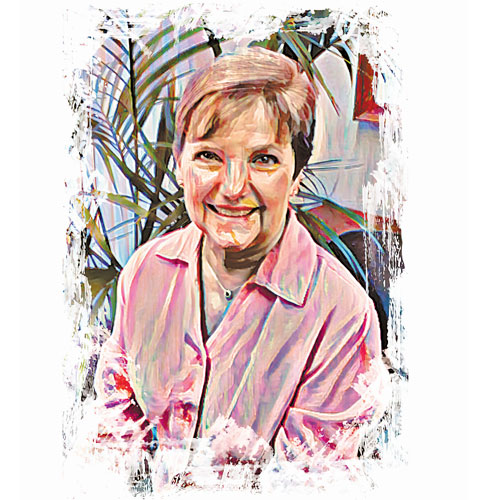
You Can and Will Become Happy
by Theresa Hauber
Aliso Viejo, Calif.
I went to my first Buddhist meeting in a time of social change, which meant that a lot of the guys at the meeting didn’t have jobs, or even shoes! But when I looked at their eyes, I thought, “I want those eyes.” They were so hopeful. I received the Gohonzon in March 1971.
Back then, we would write “Nam-myoho-renge-kyo” on the top of our World Tribune issues and go out to invite people to our discussion meetings (twice a night). The newspaper was the message; it was the vital tool that we could offer to help others connect theory to practice.
We used to collect World Tribune subscription payments in person. I remember encouraging one member to keep her subscription, which was $3 then. “I just can’t,” she told me. She had four small children and little to no money. I advised her to do what others did in those days: put aside even a nickel every time she went to the grocery store. “Just trust me,” I said.
She did just that, and based on a courageous practice, she did transform her life. Today, all her kids are successful professionals.
Today, my family and I are in good health and financially secure. I often tell members that you need wisdom, courage and compassion to sustain your practice—and that’s what the publications offer. When you’re beyond stuck and wondering how you’ll get through tomorrow, you can just open it up and read a word from Sensei. You can get out of your head. You can move beyond the part of you that wants to be defeated. You can and will become indestructibly happy.
August 15, 2024, World Tribune, pp. 4–11
You are reading {{ meterCount }} of {{ meterMax }} free premium articles

